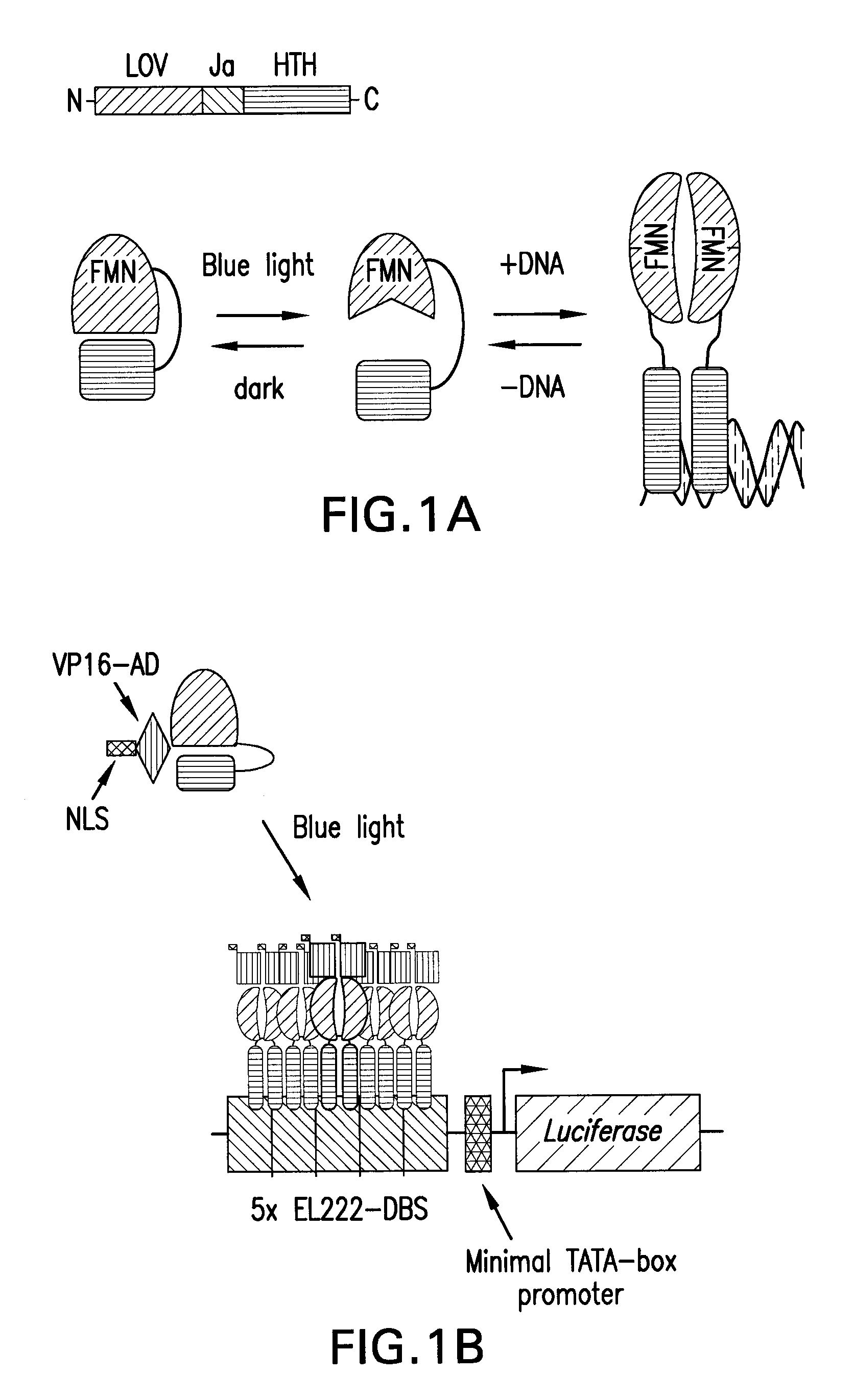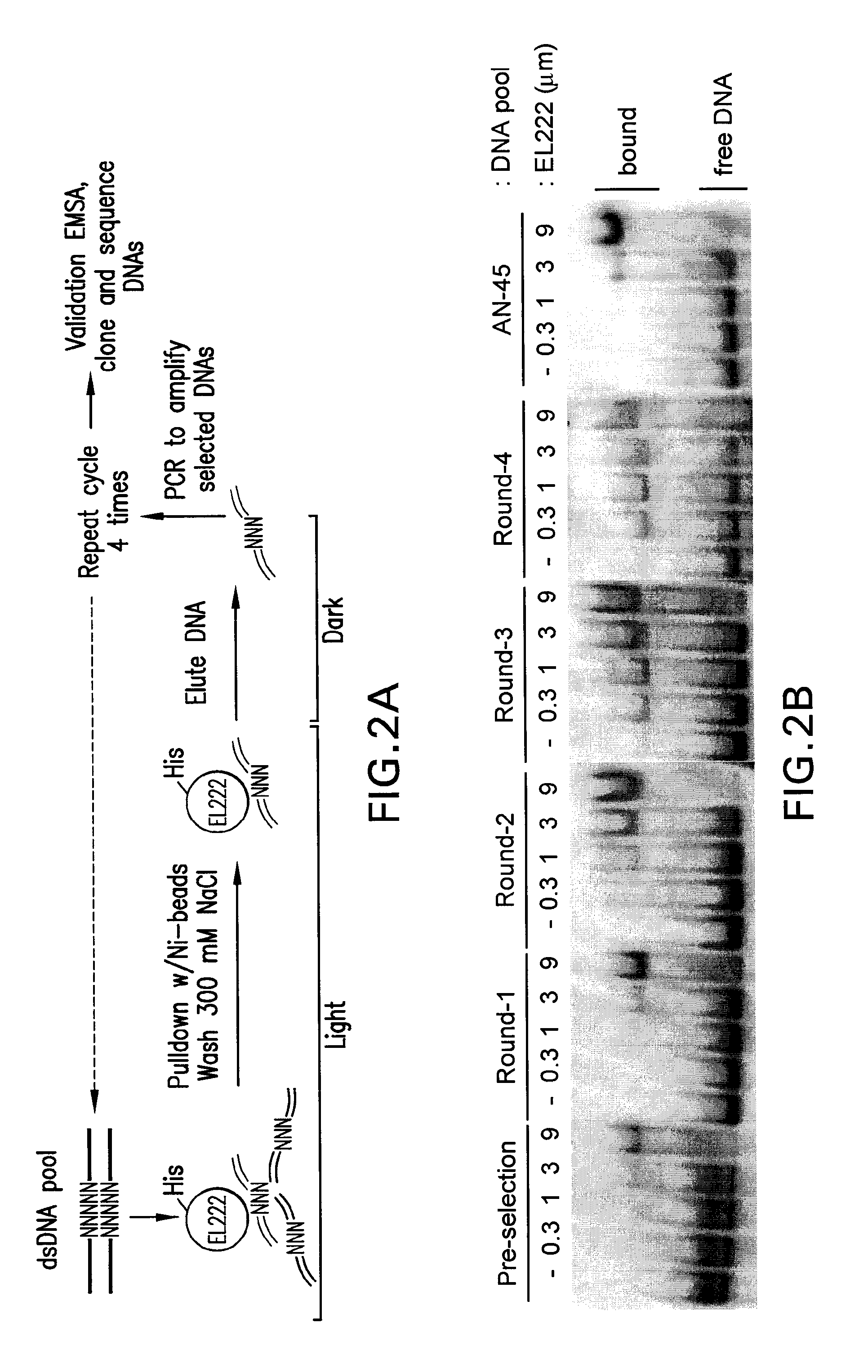Blue-light inducible system for gene expression
a gene expression and blue light technology, applied in the field of molecular biology, can solve the problems of inability to quickly turn on and off gene expression, and achieve the effect of altering the responsiveness of blue ligh
- Summary
- Abstract
- Description
- Claims
- Application Information
AI Technical Summary
Benefits of technology
Problems solved by technology
Method used
Image
Examples
example 1
Engineering the EL222 Protein
[0087]The first step taken to adapt the EL222 prokaryotic transcription factor for use in eukaryotic cells (FIG. 1) was to modify EL222 with nuclear localization and activation domains (not present in the natural protein), without hindering DNA binding or light regulation. The transcriptional activation domain (AD) from the herpes simplex virus VP16 protein, which is routinely used to efficiently recruit components of the mammalian transcription machinery to a target gene (Blau et al., Mol Cell Biol (1996)16: 2044), was fused to the EL222 coding sequence (FIG. 1b). A nuclear localization signal (NLS) was also added to properly localize the VP16-EL222 fusion protein to the nucleus. Expression of the VP16-EL222 chimera is driven from the constitutively active SV40 early promoter.
[0088]Methods
[0089]A. Vector Construction
[0090]DNA encoding a 13-residue N-terminal truncation of WT-EL222 (residues 14-222), provided as SEQ ID NO:72, was cloned into the expressi...
example 2
Identification of High Affinity DNA Binding Sites
[0094]In addition to modifying the EL222 protein, a high-affinity cognate DNA binding site (EL222) was identified and used to construct a reporter vector with tandem copies of this and a minimal TATA-box promoter in front of a Firefly luciferase gene as a test transgene. Several sites were initially identified for this purpose using a candidate-based approach based an in vitro DNA binding assay (EMSA, Electro Mobility Shift Assay) of approximately 15 sequences located upstream of the EL222 gene itself (Nash et al., 2011). From these candidates, one DNA site was identified (AN-45) that bound EL222 best in the group with an EC50 of 5-10 μM. Importantly, DNA binding occurred only when the protein / DNA mixture was exposed to light and not when kept in the dark, as expected from the presence of the photosensitive LOV domain. However, while the AN-45 substrate bound with the highest affinity of this limited set of oligonucleotides, it was su...
example 3
Light-Dependent Gene Activation in Eukaryotic Cells
[0112]Based on the in vitro binding data in Example 2, two reporter constructs were designed to test in cultured mammalian cells together with the VP16-EL222 fusion protein. Both constructs contained the Firefly luciferase gene under the control of five tandem copies of either the Clone-1 45-bp sequence or the C1-2 20-bp sequence (FIG. 4a). When co-transfected into 293T cells, the VP16-EL222 expression construct was able to activate transcription of the pClone1-45[Luc] and pClone1-20[Luc] reporters by 57-fold and 87-fold over empty vector controls respectively, when the cells were exposed to blue light (FIG. 4b). In contrast, dark state controls only showed about a 1.5 to 2-fold change in luciferase induction over empty vector for both reporters. After correcting for this small background induction in the dark, we calculated that for pClone 1-45[Luc] and pClone1-20[Luc] there is 25-fold and 58-fold increase in transgene expression d...
PUM
| Property | Measurement | Unit |
|---|---|---|
| wavelengths | aaaaa | aaaaa |
| wavelengths | aaaaa | aaaaa |
| pH | aaaaa | aaaaa |
Abstract
Description
Claims
Application Information
 Login to View More
Login to View More - R&D
- Intellectual Property
- Life Sciences
- Materials
- Tech Scout
- Unparalleled Data Quality
- Higher Quality Content
- 60% Fewer Hallucinations
Browse by: Latest US Patents, China's latest patents, Technical Efficacy Thesaurus, Application Domain, Technology Topic, Popular Technical Reports.
© 2025 PatSnap. All rights reserved.Legal|Privacy policy|Modern Slavery Act Transparency Statement|Sitemap|About US| Contact US: help@patsnap.com



